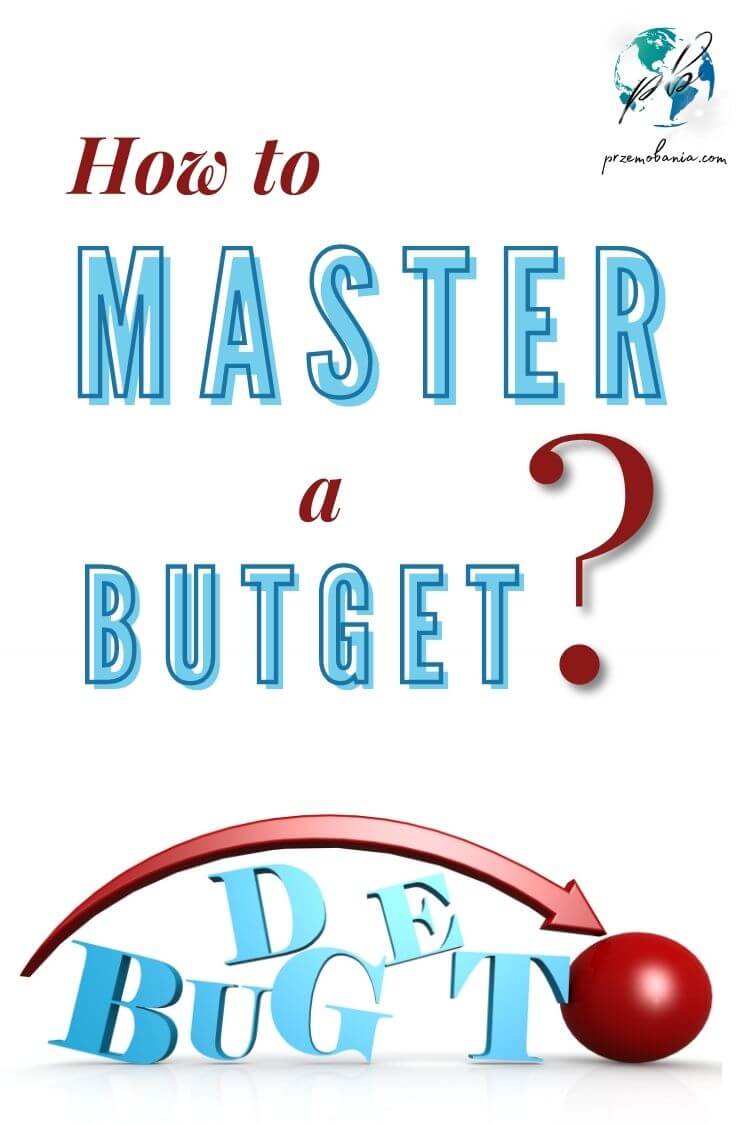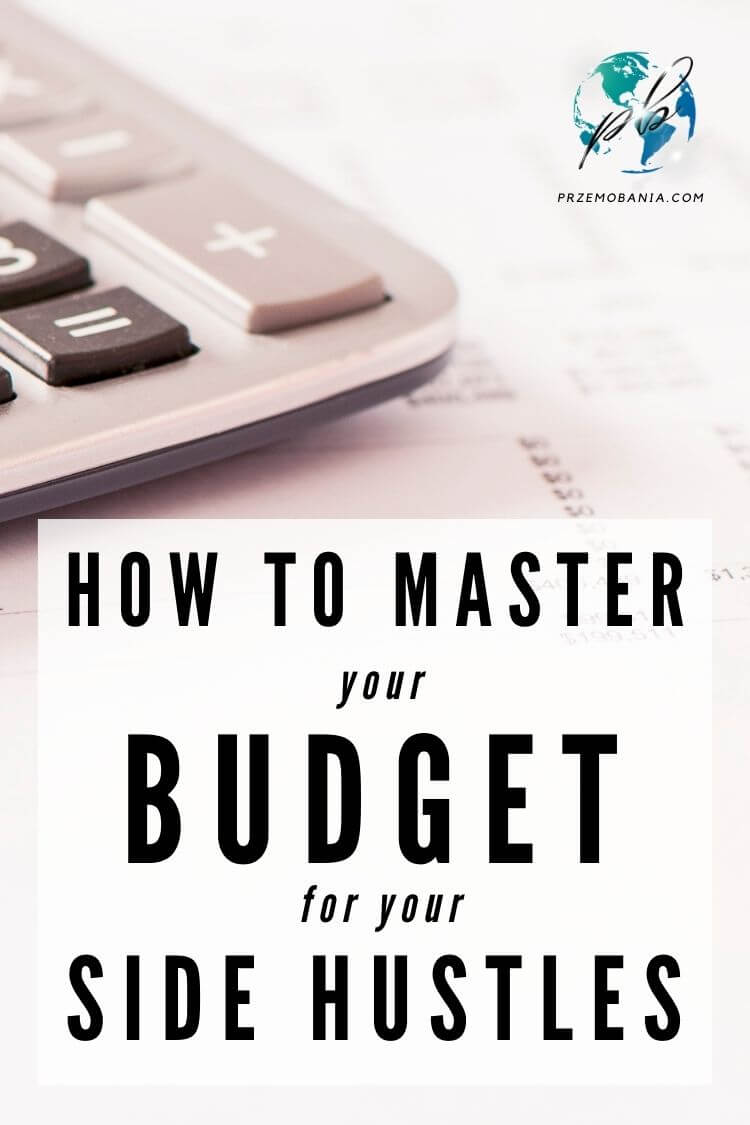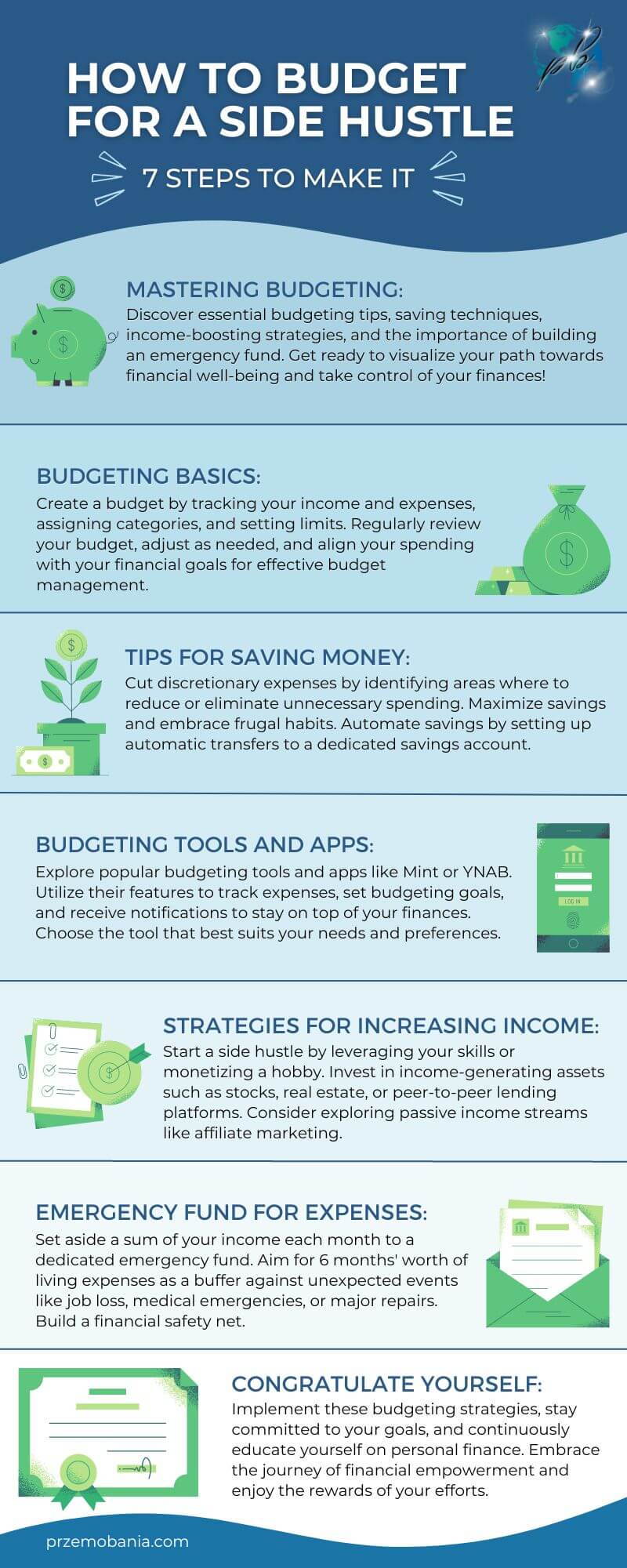How to master a budget for your side hustles?
Starting a side hustle can be an exciting adventure, a road that leads us not only to financial gains but also to personal growth and satisfaction. I’m here today to guide you through one of the most crucial aspects of that journey – to master the budget for your side hustles.
This often-overlooked element can be the key to your side hustle’s success – or the unseen pitfall that trips you up.
Believe me, I understand.
When I started my first side hustle, it was all about the big picture – the dream of financial independence, and the thrill of forging my own path. And while those visions are important, they can sometimes obscure the fine details we need to navigate to reach our destination.
One of those critical details is budgeting. It’s easy to get caught up in the enthusiasm of starting a new venture and overlook the costs involved. Even as someone with a background in personal finance, I’ve been there too.
It wasn’t until I sat down and made a comprehensive list of potential expenses that I truly understood the financial commitment of running a side hustle.
In the early days, my business was a tiny seedling. It needed care and attention to grow, and part of that nurturing process was ensuring I had the financial resources to cover my costs. And, as you’ll discover, some costs are hidden, stealthily sneaking up on you when you least expect them.
But how, in a nutshell, master a budget for your side hustles?
To master budgeting for side hustles: track all income and expenses, allocate funds wisely, set clear financial goals, regularly review and adjust your budget, and prioritize saving for taxes and emergencies. Stay disciplined and monitor your progress for financial success.
Fear not, I’m here to help you navigate this journey, just as I navigated mine.
In this post, we’ll walk through the different types of costs you might encounter, create a realistic budget for your venture, and explore ways to keep expenses low and plan for the unexpected.
Remember, every side hustle starts with a dream – and every dream is worth pursuing. Let’s make sure your financial foundations are strong enough to support yours.
Before you master your budget.
Launching a side hustle can be a thrilling journey, packed with the potential for personal growth and financial gain. Yet, it’s crucial not to overlook one vital aspect – budgeting. When I embarked on my first side hustle, I quickly realized the importance of being financially prepared.
Understanding the different types of costs is our first step.
In order to master your budget, you might face upfront expenses like purchasing equipment or software, recurring charges like website hosting or advertising, and fluctuating costs such as shipping or raw materials.
Next, we’ll look at how to formulate a budget specifically for your side hustle. This involves defining your initial budget, estimating prospective costs, and setting financial goals. I’ll guide you through the maze of numbers, just as I navigated through mine when I was at your stage.
We’ll delve into the importance of managing and tracking expenses – crucial for controlling your finances and for tax purposes. We’ll explore various tools and strategies that could assist you, including some that were invaluable in my own journey.
Additionally, we’ll discuss strategies for minimizing costs and the significance of planning for unexpected expenses. Think of this as building a financial safety net for your side hustle.
Embarking on a side hustle is an adventure, and every adventure requires a map.
Let’s chart yours together.
Why is it important to master a budget?
Before you start thinking about how to master budget you have to dive into the world of side hustles.
Your first stop should be understanding the various types of costs you might encounter. Now, you might be asking, “Why is this so important?”
Well, let me share a bit of my own journey.
When I embarked on my first side hustle, I was filled with enthusiasm and a go-getter spirit.
But, like many of us when we’re just starting, I was looking through rose-tinted glasses. It didn’t occur to me to account for all the potential expenses. And let me tell you, this oversight was a lesson learned the hard way.
So, what are the types of costs you need to consider?
First, there are the upfront costs. These are the expenses that will greet you at the door as you enter your new venture. For me, it was buying a new laptop and purchasing specific software. It could be different for you:
- Perhaps you need specialized equipment?
- Maybe you need to invest in inventory?
Next, come the recurring costs. These are the ones that stick around, the monthly or annual payments that steadily ebb away at your budget. For my online blog, it was the cost of web hosting and subscription services. If you’re running a physical product-based side hustle, you might need to consider things like rental or storage fees.
Then we have the variable costs. These are the chameleons of the cost world. They change based on the volume of your operation.
When I started selling my e-books, I had to consider payment gateway fees that varied based on the number of sales. If you’re selling products, you might need to think about costs like shipping or materials, which can fluctuate.
Finally, let’s not forget the occasional costs. These are the ones that don’t occur regularly but can suddenly pop up. For example, I remember when I had to hire a professional to fix an issue on my website – an unplanned cost that I hadn’t initially factored in.
And remember, costs aren’t always monetary. Time is a valuable resource, and it’s crucial to factor in the time you’ll invest in your side hustle. When I started, I underestimated how many hours I would spend writing, marketing, and managing my side hustle.
Recognizing these costs isn’t meant to scare you away. Quite the opposite!
It’s about going into your side hustle with your eyes wide open. It’s about being prepared, just like you’d pack an umbrella if you knew there was a chance of rain. Understanding the types of costs you might face is the first step to crafting a successful master-budget plan for your side hustle, and I’m here to guide you on this path.
In the following sections, I’ll explain in more detail the following:
- Overview of the budget creation.
- Managing and tracking expenses.
- Minimizing costs of side hustles.
- Planning for unexpected expenses.
Creating a budget to master the budget.
Venturing further into our side hustle journey, we’ve now arrived at the next important station – creating a budget.
I know, just hearing the word “budget” might make you want to run for the hills. But, trust me, having trodden this path before, I assure you it’s less daunting than it seems and it’s absolutely crucial.
When I first decided to translate my passion into a side hustle, I was brimming with excitement. The thought of setting up a budget seemed like a boring chore. But, I soon realized it was my guiding light, a roadmap that navigated me through the financial labyrinth of my new venture.
So, how do we start creating a budget for our side hustle?
First and foremost, we need to establish our starting point. This means looking at our available funds and deciding how much we are willing to invest. In my case, I set aside a portion of my savings, ensuring I had a buffer for my personal expenses. Remember, a side hustle should never endanger your financial stability.
Next, we delve into estimating potential costs...
Here, our prior understanding of the types of costs comes in handy. We can categorize our expenses into upfront, recurring, variable, and occasional costs. We might not be able to predict all costs accurately, but having an estimate gives us a working blueprint.
When I was in your shoes, I found it useful to slightly overestimate these figures – it’s better to be safe than sorry!
With our costs outlined, we can then set financial goals for our side hustle:
- Are we looking to break even in the first year?
- Are you aiming to generate a certain income after covering costs?
Your financial goals will shape your budget, guiding your spending and saving decisions.
A crucial part of budgeting is a continuous adjustment. When I started, I had a basic budget, but as I grew more accustomed to my side hustle, I revisited and refined it. An initial budget is a starting point, not a finish line.
Remember, a budget is not designed to be a financial straightjacket, limiting your side hustle’s growth. Instead, think of it as a compass, guiding you towards financial success and sustainability. And while creating a budget might seem like a daunting task, it’s a crucial step in your side hustle journey. Just like I did, you’ll find it’s worth every minute you invest in it.
Master budget by managing and tracking expenses.
As we continue on our side hustle journey, our next stop is an aspect that’s a game-changer – managing and tracking your expenses.
At first glance, this might seem like just another administrative chore. But I can’t emphasize enough the significance it holds based on my personal experience.
When I started my side hustle, I was on cloud nine, creating content, and connecting with potential clients. But amidst the hustle and bustle, keeping track of expenses seemed like a tedious task. It wasn’t until tax season approached that I realized its true importance.
Without a proper record of my expenses, I found myself scrambling at the last minute.
So how can we effectively manage and track our side hustle expenses?
First, separate your personal and business finances. When I was in your shoes, creating a separate bank account for my side hustle was one of the best decisions I made. It helped keep things organized and made it easier to track business-related expenses.
Next, consistently record your expenses. When I started, I found it helpful to schedule regular finance time each week. During these sessions, I would update my records, making note of all costs incurred. I also learned that keeping receipts and invoices was invaluable. They serve as proof of your expenses and are especially important come tax time.
But you don’t have to do it all manually.
There are numerous tools, apps, and software available to make this task easier. For me, using cloud-based accounting software was a game-changer. It allowed me to record and categorize my expenses on the go, saved time, and reduced the chances of errors.
One of the important aspects of managing expenses is understanding what counts as a deductible business expense. I consulted with a tax advisor early on, which gave me clarity about potential tax savings. You might find it beneficial to seek professional advice as well.
Remember, keeping track of your expenses is not just about having your paperwork in order. It’s about understanding how your money is spent, identifying where you can save, and ensuring you’re ready when tax time rolls around. This task may seem tedious initially, but believe me, future you will thank yourself for this diligence!
With effective expense management, you’ll be well on your way to running a financially successful side hustle.

How to master the budget by minimizing costs?
As we journey further into our side hustle adventure, our next destination holds the potential to make a significant difference – minimizing costs. When I began my side hustle, the thrill of building something of my own made it easy to overlook this aspect.
But, as I found out, keeping costs low can be the difference between a side hustle that thrives and one that merely survives.
The first strategy I found useful was bootstrapping. This means doing more with less and using minimal resources to achieve your goals. When I started, I used as many free tools as I could find and learned to wear many hats to avoid hiring outside help. Every dollar you save is a dollar that can be reinvested in your business or added to your profits.
Next, always be on the lookout for the best deals.
As I dove deeper into my side hustle, I discovered that it paid to shop around, whether for software, equipment, or services. A little bit of research can lead to significant savings. However, remember that the cheapest option isn’t always the best. It’s about finding a balance between cost and quality.
Another method to minimize costs is to use resources efficiently. In my journey, I found that streamlining my processes saved both time and money. Automating tasks where possible and eliminating unnecessary steps can go a long way in reducing costs.
Then there’s the strategy of bartering. I remember trading my writing services for graphic design work when I was starting. It’s an age-old practice, but it can still be a cost-effective way to get what you need for your side hustle.
Lastly, one thing I learned is that costs aren’t always financial. Time is a valuable resource too, and finding ways to work more efficiently can free up time to focus on other areas of your side hustle.
Remember, minimizing costs isn’t about cutting corners or sacrificing the quality of your work.
It’s about being resourceful and making smart decisions that allow you to get the most out of your side hustle. After all, the goal is to build a venture that’s not just fulfilling, but also financially sustainable. And with these strategies in mind, you’ll be well-equipped to do just that.
Master your budget by planning for the unexpected.
Our final destination in our side hustle journey is one that might not be as glamorous as the rest, but trust me, it’s just as crucial – planning for the unexpected.
When I began my side hustle, I was full of optimism, thinking that everything would go as planned. But, just like in life, the side hustle road can also throw you a few curveballs.
One thing I learned early on was the importance of setting aside funds for unexpected expenses. Like that time when my website crashed, and I had to hire a tech expert at short notice.
Or when I decided to attend a last-minute networking event that turned out to be a golden opportunity.
Having a rainy day fund gives your side hustle the resilience to weather these unforeseen costs without impacting your overall financial health.
But how much should you set aside?
In my experience, aiming for a buffer that covers around 3-6 months of your side hustle’s operating costs is a good starting point. However, the exact amount will depend on your individual circumstances and the nature of your business.
You should also consider insurance as part of your plan for the unexpected.
While it might seem like an additional expense, it’s really an investment in your side hustle’s longevity. It provides a safety net against unforeseen mishaps. In my case, getting liability insurance was a wise decision as it protected me against potential lawsuits.
Remember, planning for the unexpected isn’t about anticipating every single bump in the road – that would be impossible.
It’s about building a buffer that can absorb these shocks and allow your side hustle to continue running smoothly. Just like we carry an umbrella when there’s a chance of rain, we need to prepare our side hustle for potential financial showers.
Starting a side hustle can be both exciting and challenging. But with careful planning, thorough budgeting, diligent expense tracking, cost minimization, and preparation for unexpected expenses, you’re setting yourself up for success. It might seem like a lot, but take it from me, someone who’s been there, every step is worth it.
With these financial foundations, you’ll be ready to turn your side hustle dreams into reality.
My personal journey to master my budget.
As a fellow blogger, I know the thrill of sharing your thoughts and ideas with the world. But let’s be honest, managing the financial aspects of our blogging journey can sometimes feel like navigating a maze. To master such a budget can seem tricky.
It’s one area I grappled with in the early days of my own side hustle. But over time, I realized that with some planning, organization, and a dash of perseverance, it’s entirely possible to turn your blogging passion into a financially sustainable venture.
That’s why I want to share a roadmap I’ve created that’s close to my heart, one that I wish existed when I started out – a step-by-step guide on managing the financial aspects of your blogging side hustle.
From choosing the right blogging platform to creating an emergency fund, these are the lessons I’ve learned, the actionable steps I’ve taken, and the tools that helped me along the way.
So, whether you’re a newbie blogger just setting out or a seasoned pro looking to better manage your finances, I hope this guide lights your path. Remember, no step is too small when it comes to financial planning.
Each one is a stride towards turning your blogging dreams into reality.
So, let’s dive in!

Choosing the right blogging platform.
Now that we’ve set the stage, let’s embark on the first step of our journey – choosing the right blogging platform. This decision lays the foundation for your blogging venture. Think of it as setting up your new digital home – you’d want it to be welcoming, comfortable, and able to accommodate your needs as your blog grows.
I remember when I was in your shoes, feeling overwhelmed by the plethora of options available. WordPress, Squarespace, Wix – each with its unique features and pricing structures. But, after some thorough research and evaluation, I found the one that clicked with my blogging goals and budget.
Next, we move on to planning your content.
A well-laid content plan is a roadmap that guides your blogging journey.
When I first started, I spent hours brainstorming post ideas related to my niche. With a list of topics in hand, I then created a content calendar to ensure I posted consistently. Trust me, having this plan not only organized my thoughts but also helped maintain my posting rhythm, a key factor for a successful blog.
There’s more to cover, but I hope this gives you a flavor of the step-by-step guide that’s about to unfold. Ready to dive deeper into the financial management of your blogging side hustle?
Let’s continue our journey together.
Setting up your blogging budget.
Remember, your blog is not just a platform to express your thoughts, but also a business that has its own expenses and potential income.
In the initial phase of my blogging journey, I sat down and figured out my starting budget. It was based on what I could comfortably afford to invest in my venture without straining my personal finances.
This initial budget covered my blogging platform subscription, the cost of a domain name, and any necessary tools or software I’d need. It was a simple step but it helped set clear financial boundaries right from the start.
Estimating potential costs was the next part of my budgeting process. I made a list of all the expenses I might incur, like marketing costs, possible upgrades for my blog, or even professional services I might need down the line.
This wasn’t an exact science, but it gave me a solid idea of what to expect and helped me plan my finances accordingly.
Setting up a budget can feel like you’re diving into a sea of numbers, but take it from me, it’s worth it. By knowing what you can afford and where you plan to spend, you gain the control you need to steer your blogging side hustle in the direction you want it to go.
It’s like having a compass in your financial journey, guiding you toward your blogging goals.
So, ready for the next step?
Let’s move on to tracking and managing expenses in order to better master your budget…
Tracking and managing your blogging expenses.
In order to master your budget, you have to venture into the realm of tracking and managing your expenses.
I won’t sugarcoat it – this step requires diligence and discipline, but it’s absolutely critical in keeping your blogging business financially healthy.
When I first began, I made the decision to keep my blog finances separate from my personal ones. I set up a distinct bank account for all blog-related income and expenses. It might seem like an extra step, but trust me, it saved me hours of sifting through statements trying to remember which expenses were for my blog.
Next, I carved out a dedicated finance time in my weekly schedule.
During these sessions, I would update my records, tally up expenses, and review my budget. I found that regularly maintaining my financial records helped keep me aware of my spending and made me feel more in control.
To help automate this process, I decided to invest in budgeting or accounting software. Tools like Mint, Quicken, or even simple spreadsheets can be real lifesavers in managing and tracking your blogging expenses. For me, having this digital assistant gave me more time to focus on what I love – creating content.
Like any other journey, your financial voyage with your blog will have its ups and downs.
But with the right system in place to manage and track your expenses, you’re well-equipped to navigate through it all. This not only helps with your current financial management but also prepares you for the growth and success that’s to come.
Now, let’s explore some strategies for minimizing costs.
Shall we?
Minimizing blogging costs.
Now, let’s move forward to a topic that’s often close to every blogger’s heart – minimizing blogging costs. As someone who’s been on this journey for a while, I know the balance we need to strike between investing in our blogging venture and keeping our expenses in check.
When I was just starting, I made it a point to use free tools and resources whenever possible.
From using free themes and plugins on WordPress to utilizing free versions of graphic design tools like Canva, every penny saved contributed to my blog’s financial sustainability. I learned quickly that you don’t always need to splash out on the most expensive options to create quality content.
I also discovered the value of shopping around for the best deals on blog-related expenses.
Whether it was web hosting services or purchasing a premium tool, a bit of comparison shopping saved me more money than I initially expected. It’s worth noting, though, that while it’s important to minimize costs, it shouldn’t come at the expense of the quality of your blog.
And remember, cost minimization isn’t about skimping on every possible expense. It’s about making informed decisions on where to save and where to invest.
Every blog has unique needs, and striking the right balance is key to nurturing its growth while keeping it financially sound.
As we draw closer to the end of our journey, our next step is creating an emergency fund.
Let’s get into it!

Planning for unexpected blogging hiccups.
This is where we discuss the importance of an emergency fund for your blog. I can’t stress enough how crucial this step has been for my own blogging journey.
Life is full of unexpected twists and turns, and your blogging business is no exception. I learned this the hard way when a sudden spike in website traffic caused my site to crash, and I had to quickly upgrade my hosting plan to keep my blog running. That’s when I truly appreciated having an emergency fund in place.
So, how do you create one?
I started by allocating a certain percentage of my blog’s income each month to an emergency fund. This fund aimed to cover about 3-6 months of blogging expenses. It provided a cushion for unexpected costs that cropped up, whether they were unplanned software upgrades or emergency website maintenance.
I also explored suitable insurance coverage for my blog to protect it from potential legal or financial risks. While it’s an additional cost, it’s worth considering as part of your comprehensive financial plan.
Building an emergency fund and planning for unexpected expenses might seem daunting, but remember, it’s a step towards ensuring the stability and longevity of your blog. With this last piece in place, you’ll not only have a blog but a financially sound business ready to weather whatever comes its way.
Now that we’ve navigated through each step of managing your blogging side hustle’s finances, remember, the journey is as important as the destination. Every small step you take brings you closer to turning your blogging dreams into a sustainable reality.
Investing in your blog.
This is the point where your blog transitions from being a side hustle to potentially a significant source of income and personal fulfillment.
When I felt that my blog was stable, and I had a robust emergency fund, I began to think about areas where strategic investments could supercharge my blog’s growth. I thought long and hard about what aspects of my blog could benefit from an investment – it could be improving my blog’s design for a more professional look, acquiring powerful SEO tools to increase my blog’s visibility, or enrolling in online courses to hone my blogging skills.
However, it’s essential to make these decisions thoughtfully. I took the time to plan and budget for these investments, ensuring they didn’t endanger my financial stability. For me, it was about investing not just money, but time and energy in learning and growth.
But perhaps the most important aspect of investing in your blog is the mindset. You’re not spending money; you’re investing it in the growth of your blogging venture. Every penny put into bettering your blog is a step towards a higher return – not just in monetary terms, but in the satisfaction and accomplishment you’ll feel seeing your blog thrive.
We’re now at the end of our financial journey with our blogs.
But remember, this is just the beginning of your path to turning your passion for blogging into a successful venture. I’ve walked this road and I’m here to tell you that with careful planning, a bit of discipline, and a whole lot of heart, you can do it too.
Building a community around your blog.
You see, while we’ve covered the financial management of your blog, there’s one element that’s often the secret to a blog’s success and longevity – its community.
In my early blogging days, I often felt like I was sending my thoughts out into the void.
It was only when I started actively working on building a community around my blog that I truly began to see its potential. Engaging with my readers, responding to their comments, and really listening to what they wanted from my content; these efforts fostered a sense of connection and community that fuelled my blog’s growth.
But, building a community isn’t just about numbers or traffic, it’s also about creating a space where your readers feel heard and valued. Offering valuable content, soliciting their feedback, and even collaborating with them on certain posts or projects are ways to create a more inclusive and vibrant community.
Financially, a strong community can also lead to various monetization opportunities like partnerships, sponsorships, or even launching your own products or services down the line. But always remember, these opportunities should never compromise the trust and rapport you’ve built with your community.
Finally, as you foster this community, remember that every comment, every share, and every message is a testament to your blog’s impact. As you nurture your community, you also strengthen your blog’s financial stability and potential for growth.
It’s a beautiful cycle, isn’t it?
And with that, we’ve come full circle in our blogging journey.
Remember, managing the finances of your blog might seem daunting, but with the right tools and mindset, you’re fully capable of navigating it. I hope this guide has provided you with practical insights and encouragement in equal measure.
Now, all that’s left is for you to start your own journey. Here’s to your success and growth in the blogosphere!

Personal stories and experiences with budgeting mastery.
I am going to tell you two personal stories – Ling and Michelle in relation to budgeting.
Ling turned her frustration with her 9-to-5 job into a successful blogging career. She shares her personal finance tips and advice, guiding readers on how to save money, budget effectively, and earn more. Ling’s experiences resonate with those seeking financial freedom, making her a relatable and knowledgeable resource.
Michelle Schroeder-Gardner and Jordann Moore, are the dynamic duo who have become renowned in the personal finance space. Their blog also offers actionable advice on budgeting, saving money, investing, and getting out of debt.
Michelle’s background as a certified public accountant and author, coupled with Jordann’s extensive writing experience, make them a formidable team.
Allow me to expand on these real-life stories, and then, we’ll dive into visual aids…
Ling’s story.
Allow me to introduce you to Ling, the creative force behind the FinSavvyPanda blog. Ling’s journey is an inspiring one, driven by her determination to break free from the confines of her 9-to-5 job as a software engineer.
In 2015, Ling embarked on her blogging adventure, armed with nothing but a passion for personal finance and an eagerness to learn.
Despite having no prior experience in the world of blogging or website design, she fearlessly embraced the challenge. Through hard work and perseverance, Ling transformed her blog into a thriving platform that now generates a six-figure income.
At the heart of Ling’s blog is a mission to empower her readers in their financial journeys. She is a firm believer in the power of saving, budgeting, and earning more. Ling generously shares her own personal finance tips and advice, drawing from her own experiences.
Moreover, she goes beyond her own expertise by interviewing other experts in the field, providing diverse perspectives to her audience.
Ling’s dedication to financial literacy extends beyond her blog. She is a respected speaker at financial conferences and events, using her platform to spread the message of financial freedom.
Her contributions have not gone unnoticed, as her blog has been featured in prestigious publications such as Forbes, The Wall Street Journal, and The Huffington Post.
Visiting Ling’s blog offers a wealth of knowledge and practical insights. You can learn how to save money on everyday expenses, discover effective budgeting strategies tailored to your needs, and explore various avenues to boost your income.
Ling’s approachable writing style and actionable advice make her blog a valuable resource for anyone seeking assistance with their personal finances.
So, if you’re ready to embark on your own journey toward financial independence, Ling’s blog is the ideal companion. Her expertise, coupled with her genuine desire to help others, makes her a knowledgeable and trusted guide in the realm of personal finance.
Michelle and Jordann’s story.
Let me introduce you to the talented duo behind Making Sense of Cents. Michelle Schroeder-Gardner and Jordann Moore. Their journey in the world of personal finance is nothing short of remarkable, and their blog has become a go-to resource for countless individuals seeking financial wisdom.
Michelle Schroeder-Gardner, a certified public accountant with a degree in finance from the University of Missouri, launched Making Sense of Cents in 2011. Since then, she has emerged as one of the most influential personal finance bloggers globally.
Michelle’s expertise and passion for the subject are evident in her several books on personal finance, including the acclaimed “The Millionaire Next Door” and “The Automatic Millionaire.”
Joining forces with Michelle in 2014, Jordann Moore, a skilled freelance writer, and editor, has added her unique perspective to Making Sense of Cents.
With a degree in English from the University of Missouri and an impressive portfolio featuring notable publications like Forbes, The Huffington Post, and The Balance, Jordann brings a wealth of knowledge to the table.
Together, Michelle and Jordann provide readers with actionable advice on a wide range of personal finance topics. They dive deep into budgeting, offering practical tips on creating and sticking to a budget tailored to your needs. Saving money becomes less daunting as they share ingenious strategies for cutting costs, from everyday expenses to major purchases.
Investing can be intimidating, but fear not!
Michelle and Jordann are there to guide you, sharing their expertise on how to make your money work for you in the long run. Moreover, if you’re burdened by debt, they offer invaluable insights on how to tackle it efficiently and reclaim your financial freedom.
What sets Making Sense of Cents apart is the personal touch that Michelle and Jordann infuse into their advice.
By sharing their own stories and experiences, they make their guidance relatable and inspiring. You’ll find solace in knowing that these financial experts have faced similar challenges and come out on top.
If you’re seeking guidance on personal finance matters, Making Sense of Cents should be your go-to resource.
Michelle and Jordann’s wealth of knowledge and experience make them trustworthy mentors in the realm of personal finance. Prepare to be empowered as you embark on your journey towards financial well-being with their expert guidance by your side.
How to master your budget infographic.
To complement your journey toward financial empowerment, I’ve created an infographic that brings these budgeting principles to life showing a little bit clearer how to master your budget.
It visually summarizes key tips and strategies for effective budgeting, making it easier to digest and implement. Click on the button below to download the infographic and gain additional insights into managing your finances successfully.

Conclusion on how to master budget for your side hustles?
Mastering budgeting for your side hustles is an essential skill that can propel your financial success. By implementing effective budgeting strategies, you gain control over your finances and maximize the potential of your side hustle.
To begin, track all your income and expenses meticulously. This allows you to understand the true financial picture of your side hustle and make informed decisions. Allocate your funds wisely, prioritizing essential expenses while setting aside a portion for savings and investments.
Setting clear financial goals is crucial to master the budget.
Whether it’s paying off debt, saving for a specific purpose, or generating additional income, having goals helps guide your budgeting decisions. Regularly review and adjust your budget as needed to ensure it remains aligned with your goals and changing circumstances.
Remember to factor in saving for taxes and unexpected emergencies. Set aside a portion of your side hustle earnings for taxes to avoid any unpleasant surprises. Additionally, build an emergency fund to provide a safety net in case of unforeseen expenses or fluctuations in your income.
Maintaining discipline is key to mastering budgeting. Stay focused, avoid unnecessary expenses, and resist the temptation to overspend. Monitor your progress regularly, celebrate milestones, and make adjustments when necessary.
In order to master the budget for your side hustles, you empower yourself to make sound financial decisions, achieve your goals, and experience greater financial stability. With a clear understanding of your income, expenses, and savings, you can confidently navigate the financial landscape and unlock the full potential of your side hustle.
Embrace the journey, stay committed to your budgeting practices, and watch your financial dreams become a reality.
FAQ about how to master the budget.


Przemo Bania is a blogger and writer who helps people get out of their traditional jobs to start a blogging career. Przemo also runs a health blog advocating for endometriosis and fibromyalgia…

